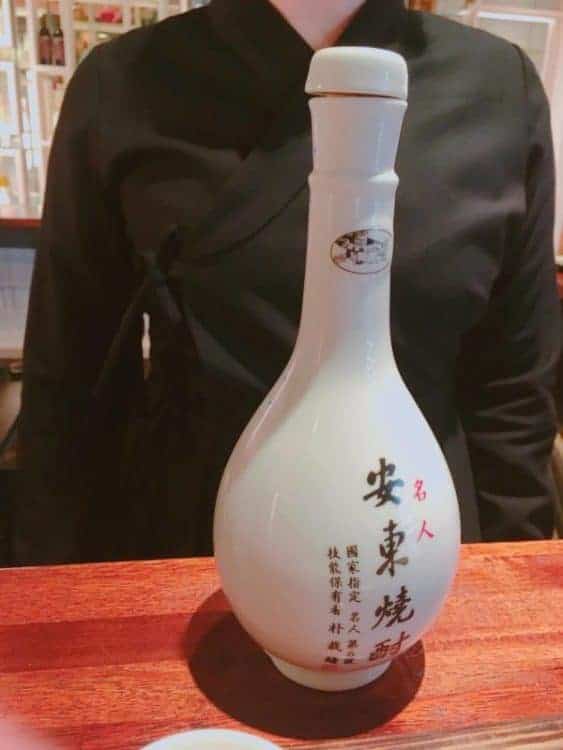Visiting The Sool Gallery, Seoul [2024 Guide & Review]
The Sool Gallery in Seoul (전통주갤러리) opened several years ago. It was introduced as part of an initiative by the Korean tourism board. Following a temporary closure and a change to a new location, it reopened in 2023 and the gallery is ready to receive tourists again.
The idea behind the Sool Gallery has always been to introduce Korean alcoholic beverages to the world. The gallery is dedicated to spreading the cultural context and historical significance of Korean alcohol, making the gallery “a one-stop destination for all things liquor and wine.”
The Sool Gallery Seoul

The Sool Gallery (South Korea, Seoul, Jongno-gu, Jae-dong, 54-5 1층) awaits in Jongno-gu, close to Anguk metro station in central Seoul. It has recently moved from its former location in Gangnam
Very little is known about Korean alcohol internationally which is a shame. Everybody knows about Japanese saki or Greek alcoholic beverages like ouzo but when you ask them about traditional Korean alcohol they draw a blank.
Many Korean beverages such as soju and makgeolli are flavourful and suited to a western palette. They are widely available in the bars and restaurants of Seoul.
However, if you have never tried them before, ordering something unknown can be a little intimidating. That’s where the Sool Gallery comes in.
If you ever find yourself in Jongno-gu, you will have the opportunity to sample an array of traditional Korean wines and liquors at the Sool Gallery. This initiative is free!
Korean Drinking Culture
If you have spent any amount of time in Korea, you will certainly have noticed that drinking is a large part of the culture. Soju 소주 is a regular guest at dinner tables, social gatherings, and parties.
The commonly consumed drinks of soju, makgeolli (Korean rice wine), and somaek 소맥 (Soju mixed with Korean beer) are extremely cheap and cheerful. You can buy bottles of soju and makgeolli for just a few dollars in Korean convenience stores.
So it is easy for your first impression of Korean drinking culture to be that the beverages here are restricted to the cheap plastic bottles of makgeolli and soju that you find in 7/11. Interestingly, a lot of Koreans think the same.
Very few locals know much about the country’s traditional alcohols. Locally, Korean alcohol is not known for being elegant, or of high quality.
This is why the Korean Government is introducing initiatives like The Sool Gallery. There is a hope of raising awareness about the various Korean drink options and putting Korea on the map as a quality alcohol producer.
Traditional Korean Dishes with Liquor from the Sool Gallery
One of the joys of exploring Seoul’s vibrant culinary landscape is discovering the harmonious relationship between traditional Korean dishes and the country’s iconic liquors. Visiting the Sool Gallery offers a unique insight into the art of Korean alcohol, but to truly appreciate the depth of this cultural gem, one must delve into the art of pairing these beverages with the right food. Here’s a guide to enhancing your dining experience by marrying the rich flavors of Korean liquor with the country’s traditional dishes.
Soju and Samgyeopsal: A Classic Duo
- The Pairing: Soju, Korea’s most popular spirit, with Samgyeopsal (grilled pork belly).
- Why It Works: The clean, sharp taste of soju cuts through the fattiness of the pork, cleansing the palate and preparing it for the next savory bite.
- Sool Gallery Insight: Explore variations of traditionally distilled soju at the Sool Gallery to elevate this pairing.
Makgeolli and Pajeon: Rainy Day Comfort
- The Pairing: Makgeolli (Korean rice wine) with Pajeon (green onion pancake).
- Why It Works: The slightly sweet and tangy profile of makgeolli complements the savory, crispy texture of pajeon, making it a favorite comfort food pairing, especially on rainy days.
- Sool Gallery Tip: Ask for a Makgeolli tasting to find your preferred sweetness level for this pairing.
Yakju and Hanjeongsik: A Noble Feast
- The Pairing: Yakju (refined rice wine) with Hanjeongsik (a full-course Korean meal).
- Why It Works: The subtle, aromatic qualities of yakju enhance the diverse flavors of a traditional Korean feast, echoing the dining habits of Korean nobility.
- Experience at Sool Gallery: Delve into the history of yakju and its prestigious status during your visit to understand its regal pairing.
Dongdongju and Jeon: The Festive Match
- The Pairing: Dongdongju (a variation of Makgeolli) with Jeon (Korean style pancakes with various fillings).
- Why It Works: Dongdongju’s thicker texture and richer flavors harmonize with the assortment of jeon, making it a perfect match for celebrations and festive occasions.
- Sool Gallery Exploration: Discover the seasonal variations of Dongdongju that could highlight this pairing.
Soju and Korean Fried Chicken: The Modern Twist
- The Pairing: Flavored soju (with fruits like grapefruit or green grape) with Korean Fried Chicken.
- Why It Works: The fruity, refreshing soju complements the crispy, often spicy, chicken, creating a fusion of flavors that’s irresistibly modern.
- Sool Gallery Suggestion: Sample the flavored sojus and learn about their infusion process during your visit.
Visiting the Sool Gallery not only opens up a world of traditional Korean liquors but also offers a deeper understanding of how these beverages can enhance the Korean dining experience. Whether you’re indulging in the rich flavors of a Hanjeongsik or enjoying the simple pleasure of fried chicken and soju, the right pairing can elevate your meal from delicious to unforgettable. So, next time you’re navigating the culinary landscape of Seoul, let the insights from the Sool Gallery guide your choices, leading you to perfect harmony on your plate and in your glass.
Visiting the Sool Gallery in Seoul
When you arrive at the Sool Gallery in Seoul, you will be greeted by a Korean Sommelier. They will provide you with a bit of background info on the initiative and then speak you through the production process for making various Korean alcohols.
Firstly, they will talk you through the process of making Korean wines.
It is interesting to learn about the ingredients used and the processes followed. Many Korean beverages use seasonal ingredients that are only found at certain times of the year.
Korea sees some fairly extreme climates. It has hot, humid, monsoon-like summers and cold, harsh winters.
This means that Korean alcoholic beverages are also seasonal, and many can only be produced at certain points of the year.
Tastings at the Sool Gallery
After the tour, we tasted a selection of traditional Korean alcohol. The curators select 10-20 new tipples each month, all surrounding a particular theme.
This is so as to keep the selection interesting, and fresh for any alcoholics repeat visitors. We sampled Makgeolli 막걸리, Yakju 약주, traditionally distilled soju 소주, and Korean wines.
Soju, Makgeolli, and Yakju – Oh My!
The traditional soju 소주 weighs in at 40% proof. It tasted completely different from the green bottle of soju that you see in stores and bars around Korea.
The taste reminded me somewhat of a scotch whiskey and was so strong that it made my eyes water! Apparently, the translation for soju is “burning alcohol”. This ought to give you a little pre-warning about the kick it gives!
Makgeolli 막걸리
Makgeolli 막걸리 is Korean rice wine. This is considered the most refreshing Korean alcohol to drink due to its short fermentation time.
Makgeolli’s fermentation period is kept short in order to preserve the flavours. This is far and above a favourite Korean alcohol of many.
If you are new to Seoul, you should consider heading to one of the traditional Makgeolli houses in Insadong. Here you can experiment with many different types from the local breweries.
Makgeolli is served alongside Korean street food snacks like kimchi jeon and other treats.
Yakju 약주
Yakju 약주 is a filtered Takju and comes from the Korean word “Yak” meaning medicine. It is infused with various aromatic herbs and has a somewhat spiced taste. This was previously the preferred drink of Korean nobles.
A New Era of Korean Liquor Production
Many Korean producers are now branching out from traditional processes and methods. More and more companies are experimenting with more Western-style wines.
We trialed an absolutely delicious strawberry-infused grape wine, and an omija 오미자 (Korean berry) wine. Korean wines are very sweet-tasting. They are not too dissimilar to European dessert wines.
The Sool Gallery is a really beautiful space and the store within offers many ornate-looking bottles of wine and drinking accessories. The tour and tasting took a little over an hour. They are completely free as part of a government incentive (#mykindagovernment).
Additional Information
The Sool Gallery has recently moved locations for the third time in the past 7 years. Check the address before you travel as many online resources still refer to the gallery’s old address.
They previously only had a Naver blog website. However, with their new dedicated webpage, you can make a reservation online in advance via their online booking system. (You can also call or send an email if you prefer).
Address: South Korea, Seoul, Jongno-gu, Jae-dong, 54-5 1층l (서울특별시 종로구 재동 54-5 1층) [Anguk station]
Website: click here
Email: [email protected] (Korean, English, Japanese, Chinese)
Contact Number: 02-555-2283 (Korean, English, Japanese, Chinese)
Opening Times: Open 10 am – 8 pm Tuesday – Sunday. [Please note, a forward reservation is required via email for the tour and tasting, but if you just want to wander around the gallery and take a look alone then you can just drop by]
Tours: English tours are available at 2 pm, or 4 pm daily.
Final thoughts
A visit to the Sool Gallery can be a highlight of any Seoul itinerary or wider Korea itinerary. Better yet, it’s free and provides excellent insight into Korean culture and traditions.
Have you tried Korean liquor before? What did you think?
Have a wonderful time travelling around South Korea. Annyeonghaseyo!
Disclaimer: High Heels and a Backpack is in no way affiliated with The Sool Gallery.


One Comment